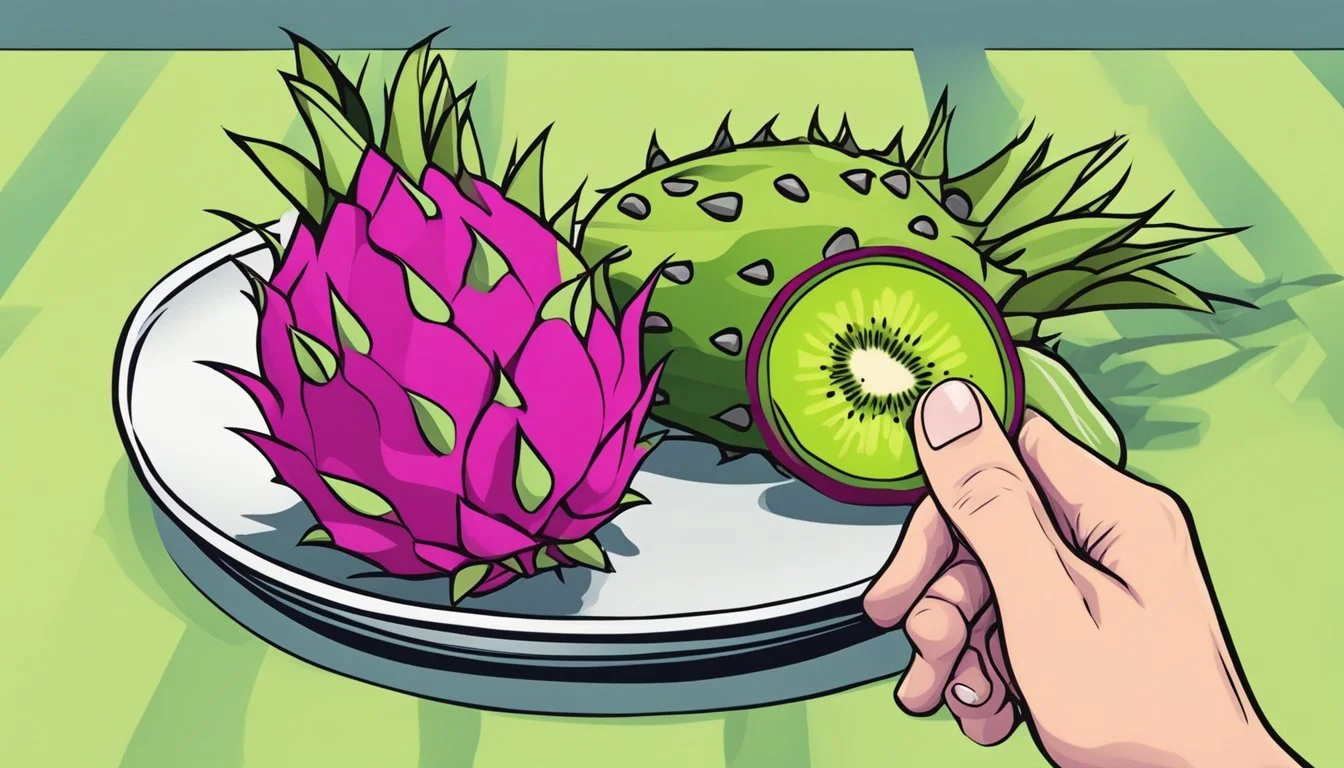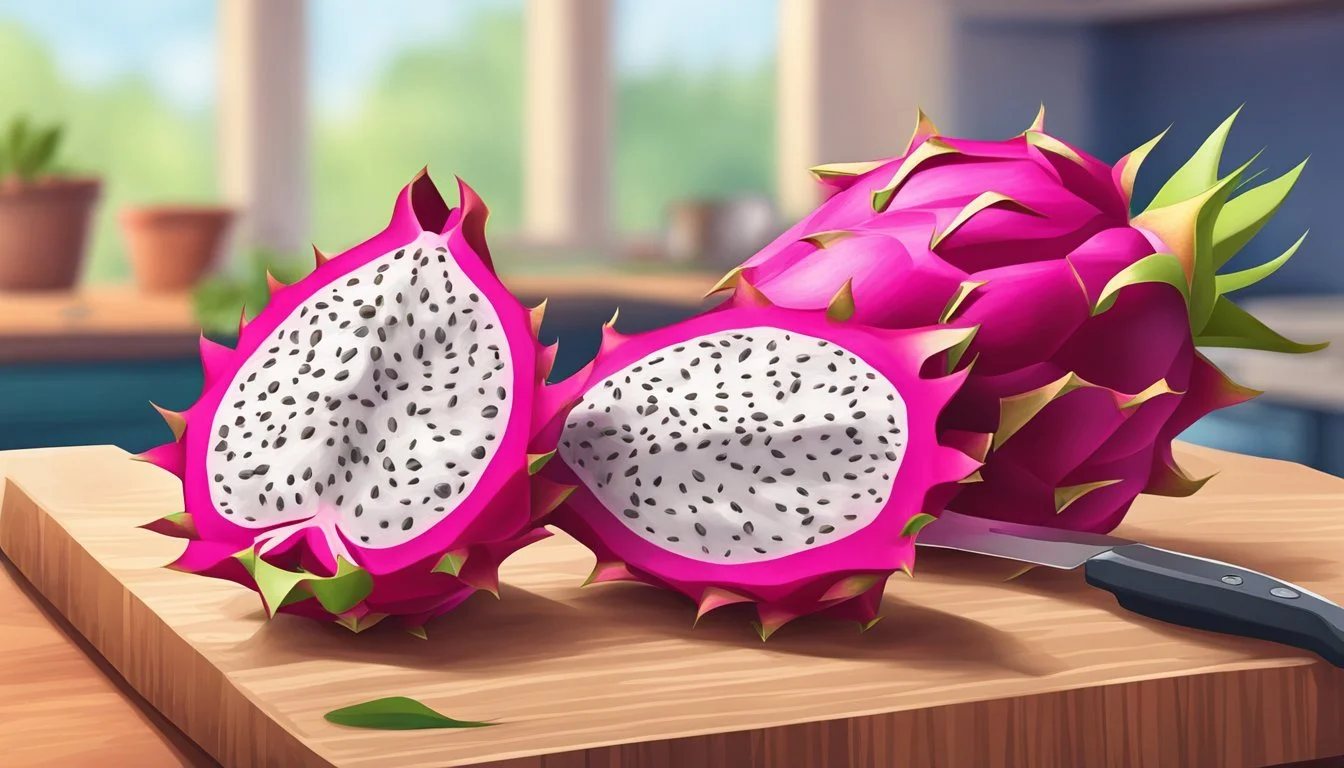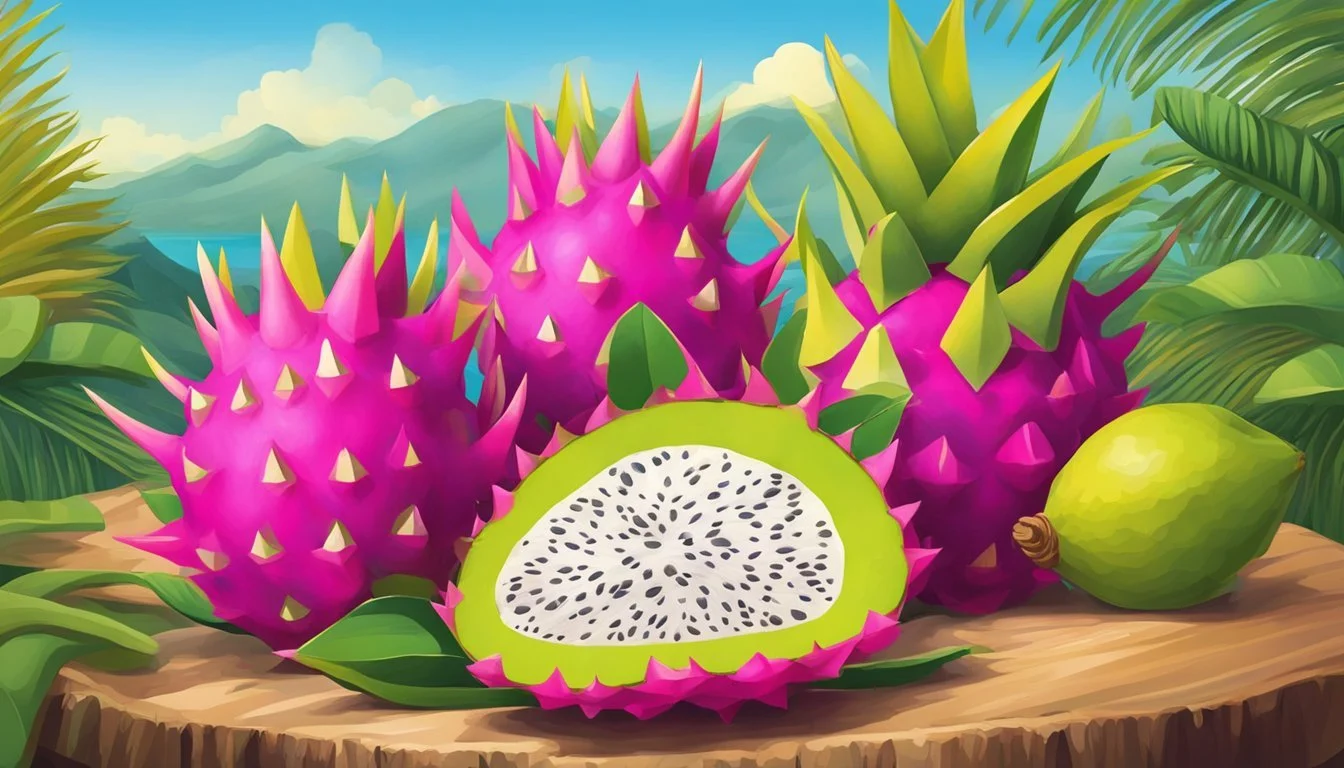How to Substitute Pitaya for Kiwi
A Simple Swap Guide
In the realm of vibrant and nutritious fruits (What wine goes well with fruits?), pitaya, or dragon fruit, stands out with its bright hues and unique texture. When seeking a substitute for kiwi, with its similarly tender flesh and a delightful balance of sweet and tart, dragon fruit is an alternative that can mimic the texture and visual appeal of kiwi in various culinary applications. Native to the Americas but now cultivated in regions worldwide, pitaya is typically sweeter than kiwi but can be adapted to fill kiwi's role in recipes.
The key to using dragon fruit as a substitute lies in balancing its flavors to match the characteristic zest of kiwi. By introducing citrus elements, such as lime or lemon juice, the sweeter profile of dragon fruit can be tweaked to emulate the tangy kick that kiwi provides. This adjustment allows dragon fruit to seamlessly integrate into dishes typically garnished with kiwi, from fruit salads to tropical salsas, preserving the intended sensory experience.
Although both fruits exhibit distinct flavors, their similar seed distribution and comparable structural integrity underpin the feasibility of this substitution. When kiwi is unavailable or a recipe demands a visual twist without compromising on taste, dragon fruit stands as a competent stand-in. The transition between the two fruits in culinary use reflects a broader appreciation for the interchangeability of ingredients and the creative adaptation in cooking.
Understanding Pitaya and Kiwi
Before comparing pitaya to kiwi, it's essential to understand their distinct nutritional values, flavors, and physical characteristics. They both provide unique taste profiles and health benefits that are valuable to a balanced diet.
Nutritional Profiles
Pitaya (Dragon Fruit)
Calories: Low
Fiber: High
Vitamin C: High
Antioxidants: Contains antioxidants like betalains, hydroxycinnamates, and flavonoids
Kiwi
Calories: Low
Fiber: High
Vitamin C: Very high (higher than in pitaya)
Other Nutrients: Rich in vitamin K, vitamin E, and potassium
Flavor and Taste Comparisons
The taste of pitaya is often described as a blend of watermelon, pear, and kiwi, with a mildly sweet flavor. In contrast, kiwi has a vibrant, tangy taste that is both sweet and slightly acidic.
Texture and Appearance Differences
Pitaya has a soft texture with tiny, edible seeds, much like kiwi but less firm. Its skin is vibrant pink or yellow, while the flesh inside can be white or red.
Kiwi is known for its fuzzy exterior and bright green flesh dotted with black seeds. Its texture is soft yet slightly firmer than pitaya when ripe.
Preparation and Usage Techniques
When substituting dragon fruit for kiwi in recipes, chefs should consider the texture and moisture content differences between the two fruits. Dragon fruit, also known as pitaya, offers a slightly crunchier texture and a milder flavor profile. Below are techniques one should follow to ensure a successful culinary substitution.
Cutting and Peeling
To use dragon fruit in place of kiwi, first, wash the fruit thoroughly. Using a sharp knife, slice the dragon fruit lengthwise. Then, similar to an avocado, one can either use a spoon to scoop out the flesh or peel away the skin. In recipes where kiwi is diced, pitaya can be cut into cubes of similar size for ease of substitution.
Cooked and Raw Applications
Dragon fruit can be used both raw or cooked in various recipes. When eaten raw, pitaya provides a refreshing crunch not dissimilar to that of kiwifruit. Its seeds offer a nutty flavor and are edible, just like kiwi seeds. In cooked applications where kiwi might be used, such as in compotes or used as a garnish, proceed to gently incorporate dragon fruit at the end of the cooking process to maintain its textual integrity.
Application Dragon Fruit Usage Kiwi Usage Raw Salads Mix in cubes Sliced Garnishes Use slivers or balls Thin slices Desserts Fold in cubes/purees Mixed in slices
Juicing and Pureeing
When preparing juice or puree as a kiwi substitute, dragon fruit's mild taste means it might require additional sweeteners or more robust-flavored fruits to match the kiwi's tanginess. For juicing, pitaya can be blended and strained, leaving out the seeds if desired. Pureeing the flesh creates a smooth texture for smoothie bowls, dressings, or dessert bases.
Recipe Adaptations
When substituting pitaya for kiwi, one must consider the differences in flavor and texture, as well as how these changes will interact with other ingredients in various dishes.
Pitaya-Based Fruit Salads
In fruit salads, pitaya can effectively replace kiwi, bringing a mild sweetness and a vibrant color. To match the tangy kick of kiwi, a splash of lime juice may be added.
Texture: Pitaya's flesh is slightly crunchier than kiwi, yet it complements other fruits well.
Appearance: The bright pink flesh of dragon fruit enhances visual appeal.
Pairing: Combine with strawberries, bananas, and a hint of citrus to balance the flavor profile.
Smoothie Considerations
Pitaya can be swapped into smoothies in place of kiwi, with some tweaks for taste and consistency:
Taste: To emulate kiwi's tartness, incorporate a small amount of lemon or lime juice.
Consistency: For a smooth texture, blend pitaya thoroughly, as it does not have the same natural creaminess as kiwi.
Additional Ingredients: Adding banana can compensate for the creaminess, and berries can offer a complementary flavor.
Dessert Modifications
When modifying desserts, pitaya's visual appeal and subtle taste can play a unique role:
Taste: Enhance the flavor with a mix of berries or citrus fruits for a diverse palate that rivals the distinct taste of kiwi.
Texture: If the dessert requires the soft texture of kiwi, adjust the amount of other moist ingredients, since pitaya is typically less juicy.
Applications: Use pitaya in frozen desserts, parfaits, and cakes to create a dessert that is as appealing to the eye as it is in flavor.
In each adaptation, ensure pitaya is ripe for the best taste and texture.
Health and Dietary Benefits
Substituting pitaya for kiwi can offer a variety of health and dietary benefits due to its nutrient profile. Both fruits confer essential vitamins and minerals, support digestion and the immune system, and may influence cholesterol and blood sugar levels positively.
Vitamin and Mineral Content
Pitaya, commonly known as dragon fruit, is loaded with vitamins and minerals. It boasts a high Vitamin C content and has notable amounts of iron and magnesium. One dragon fruit typically contains:
Vitamin C: Essential for immune system function and skin health.
Iron: Helps in transporting oxygen throughout the body.
Magnesium: Supports muscle and nerve function and energy production.
In contrast, kiwi is also rich in Vitamin C but presents a different profile of nutrients.
Digestive and Immune Support
In terms of fiber, pitaya stands out, which is crucial for smooth digestion. A single dragon fruit contains approximately:
Fiber: 3 grams per serving.
Adequate fiber intake can aid in regular bowel movements and contributes to gut health. The antioxidants found in pitaya are said to bolster the immune system's defenses.
Impact on Cholesterol and Blood Sugar
Including pitaya in one's diet has potential health benefits in managing cholesterol levels and blood sugar. Its fiber content can help in reducing bad cholesterol levels. Moreover, the fruit's low glycemic index means it aids in maintaining stable blood sugar levels, which is beneficial for individuals managing type 2 diabetes.
Selecting and Storing Pitaya
Selecting the right pitaya and storing it properly ensures maximum freshness and taste. The reader will learn how to identify ripe fruit and maintain optimal storage conditions to extend the pitaya's shelf life.
Spotting Ripeness
A ripe pitaya has bright, evenly colored skin, whether it is pink, red, or yellow. The skin should give slightly to the touch, similar to a ripe avocado, without any deep indentations. A fresh, pliant stem is a good indicator of ripeness, as a brittle stem signals overripeness.
Proper Storage Conditions
To preserve a pitaya's quality, it should be stored in a clean airtight bag or container to isolate it from external odors. The ideal storage location is a refrigerator, set to:
Temperature Condition 5°C (41°F) Cold and dry climate to slow down ripening process
Fruits should be placed away from items with strong smells, as they can absorb these odors.
Shelf Life and Preservation
At room temperature, pitaya will ripen over a couple of days. However, when stored correctly in a refrigerator, it can last for:
Storage Location Expected Shelf Life Room Temperature 1-2 days Refrigerator 2-3 weeks
For longer storage, one can write the storage date on the container or bag for reference, ensuring the fruit is consumed while at peak quality.
Understanding Varieties and Species
In selecting a substitute for kiwi, knowledge of the specific varieties and species of pitaya, also known as dragon fruit, is crucial. Equally important is understanding the regional species of kiwi to match taste and texture profiles effectively.
Common Pitaya Varieties
Pitaya, widely known as dragon fruit, is primarily found in three species: Hylocereus undatus which delivers white fleshed fruit, Hylocereus costaricensis known for its red flesh, and Hylocereus megalanthus featuring yellow skin and white flesh. These species are differentiated by their fruit skin color, flesh, and seed presence.
Hylocereus undatus (White Dragon Fruit/Pitahaya): Recognizable by its white flesh and black seeds.
Hylocereus costaricensis (Red Dragon Fruit): Has red flesh and is also referred to as 'Costa Rica night-blooming cactus'.
Hylocereus megalanthus (Yellow Dragon Fruit): Often called 'Yellow Pitahaya', it is smaller in size with white flesh and black seeds.
Within these species are popular varieties like 'American Beauty', 'Cosmic Charlie', and 'Purple Haze' – each with unique taste profiles ranging from sweet to tangy, adding to their suitability as kiwi substitutes.
Regional Species of Kiwi
Kiwi, or Actinidia, has several species but the most common one found in grocery stores is Actinidia deliciosa. Known as the fuzzy kiwi due to its brown fuzzy skin and bright green flesh, it is the main species that one might consider when looking to substitute with pitaya. Other notable species include:
Actinidia chinensis (Golden Kiwi): With a smooth, bronze skin, the golden kiwi is less acidic than the green variety and has a tropical flavor.
Actinidia arguta (Hardy Kiwi): This species is smaller and can withstand colder climates. They have a smooth skin and are eaten whole.
When substituting kiwi, attention to these differences in taste, texture, and appearance as compared to pitaya varieties will ensure a fitting match for culinary needs.
Cultural and Geographical Considerations
Substituting pitaya for kiwi takes into account various cultural preferences and geographical availabilities. Distinct differences shape their presence in diets around the world.
Pitaya in Traditional Diets
Pitaya, commonly known as dragon fruit, holds a significant position in the diets of indigenous populations in Mexico and Central America. Here, it is not merely a tropical fruit but a cultural staple. Mexico celebrates pitaya for its refreshing taste with local festivals, integrating it into traditional cuisines. In Vietnam and Southeast Asia, where the fruit is indigenous, it is a common part of the diet and often consumed fresh.
Mexico: Celebrated in local festivals; traditional consumption
Vietnam/Southeast Asia: Indigenous; regularly consumed fresh
Kiwi's Popularity around the World
Kiwi, by contrast, is a fruit favored for its tangy flavor and nutritional benefits, experiencing widespread popularity across different continents. Originating from China, it gained its name from its resemblance to New Zealand's kiwi bird. In the United States and Europe, kiwi is widely available and is a common choice for its exotic appeal and versatility in dishes.
Origin: China
United States/Europe: Widely popular; exotic appeal
Kiwi and pitaya both offer unique flavors and textures, appealing to different palates. Substitution also considers availability: kiwi is globally accessible, while pitaya is more region-specific in areas like Costa Rica and South American countries. Consumers may find pitaya a suitable alternative for kiwi due to similar textures, but taste profiles differ, reflecting each fruit's unique cultural and geographical backdrop.
Shopping for Pitaya and Substitutes
When looking to replace kiwi with pitaya, also known as dragon fruit, shoppers should familiarize themselves with places that stock fresh exotic fruits and understand how to select quality alternatives.
Where to Buy Fresh Fruits
Markets: Buyers should seek out supermarkets or local farmers' markets that carry a selection of exotic fruits. Pitaya, being a tropical fruit, is commonly found in the produce section alongside other exotic items.
Supermarkets: Check for a dedicated exotic fruit section.
Farmers' markets: Inquire with vendors who specialize in tropical produce.
Tips for Selecting Pitaya:
Color: Look for a bright, even-colored skin, indicating ripeness.
Texture: The fruit should give slightly under pressure but not be too soft, which can suggest overripeness.
Finding Alternatives in Markets
If pitaya is unavailable, shoppers can consider other fruits as substitutes in recipes calling for kiwi. It is important to match the texture and sweetness level as closely as possible.
Common Alternatives:
Mango: Offers a similar tropical sweetness, though less tart.
Papaya: Has a similar texture, but a milder flavor.
Berries: Raspberries or strawberries can mimic the tartness of kiwi but are juicier.
Availability:
Seasonality: Keep in mind that exotic fruits like pitaya have peak seasons which can affect availability.
Global regions: Availability may vary depending on one's location and the time of year.
Incorporating Pitaya in a Healthy Diet
Pitaya, or dragon fruit, stands out as a nutrient-dense option that is low in calories yet rich in fiber and vitamins, contributing positively to digestive health, anti-inflammatory processes, and heart health.
Simple Pitaya Inclusions
To integrate pitaya into one's diet effectively, one might consider adding it to morning cereals or yogurt for a fiber-rich start to the day. Fresh pitaya can be diced into salads for a splash of color and a nutritious boost or blended into smoothies for enhanced flavor and health benefits.
Breakfast: Add cubed pitaya to oatmeal or yogurt
Salads: Toss in pitaya slices with greens and a vinaigrette
Smoothies: Combine pitaya with other fruits and a liquid base
Balancing Sweetness and Acidity
While pitaya's naturally mild sweetness complements an array of dishes, the balance of sweetness and acidity is crucial. For those accustomed to the sharper tang of kiwi, a squeeze of lime juice can emulate this profile when substituting with pitaya. The fruit's versatility extends to savory dishes, where it can be used to offset the richness of meats with its refreshing taste.
Squeeze of Lime: Enhance pitaya's flavor in fruit salads or drinks
Savory Pairings: Use pitaya as a garnish on meat dishes to bring a subtle sweet contrast
Potential Health Risks and Allergies
When substituting pitaya for kiwi, it's important to be aware of possible health risks and allergies that may arise. Pitaya, also known as dragon fruit, is generally safe and healthy for consumption, but like all foods, it can cause allergic reactions in some individuals and should be consumed in moderation.
Identifying Allergic Reactions
Symptoms of Allergic Reactions:
Oral Allergy Syndrome (OAS): May manifest as itching and swelling of the mouth, lips, and throat.
Skin Reactions: May include hives or a rash.
Gastrointestinal Distress: Could involve stomach pain, vomiting, or diarrhea.
If a person exhibits symptoms of an allergic reaction after consuming pitaya or kiwi, they should seek medical advice.
Concerns with Overconsumption
Dietary Considerations:
Calories: Although pitaya is low in calories, excessive consumption can lead to increased caloric intake.
Health Benefits: Pitaya contains vitamins and minerals beneficial for the immune system and may possess anti-inflammatory properties.
Digestive Health: Overconsumption might disturb the gastrointestinal tract, especially in those with sensitivities.
Individuals should enjoy pitaya in appropriate amounts to gain its health benefits without overburdening the body.
Environmental Impact and Sustainability
Both kiwi and pitaya have distinct agricultural practices and contribute differently to environmental sustainability. Understanding their cultivation requirements and the environmental implications of consuming these fruits can inform more sustainable choices in diets.
Agricultural Practices for Kiwi and Pitaya
Kiwi cultivation requires temperate climates and can have a high water footprint when not managed sustainably. They are typically grown in countries like New Zealand, Italy, and the United States. Kiwi plants also demand sturdy support systems as they grow on vines. In contrast, pitaya is a cactus species indigenous to the Americas and thrives in subtropical and tropical climates with minimal water. Pitaya's resilience makes it less taxing on water resources and often allows growers to utilize more sustainable irrigation practices.
Water Usage:
Kiwi: High water demand. Requires irrigation.
Pitaya: Low water demand. Suitable for arid climates.
Climate Requirements:
Kiwi: Temperate regions.
Pitaya: Subtropical to tropical regions.
Sustainability and Food Miles
When considering the sustainability of kiwi and pitaya, food miles, or the distance food travels from where it is produced to where it is consumed, are an important factor. Sustainable eating involves selecting locally produced foods when possible to reduce carbon emissions associated with transportation. For consumers in Mesoamerica, where pitaya is native, opting for pitaya over kiwi can significantly reduce food miles. Similarly, for consumers in kiwi-growing regions, choosing locally grown kiwi over imported pitaya can minimize environmental impact.
Food Miles Impact:
Locally produced pitaya or kiwi: Lower food miles, reduced carbon footprint.
Imported pitaya or kiwi: Higher food miles, greater environmental impact.
Selecting fruits based on regional availability and the sustainability of agricultural practices can significantly decrease the environmental impact of one's diet. Both pitaya and kiwi can be part of sustainable eating patterns when chosen thoughtfully with attention to food miles and agricultural sustainability.










